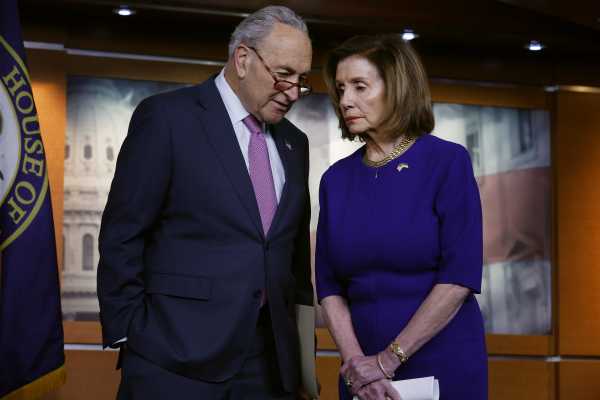
Part of The 2022 midterm elections, explained
The 2022 midterm vibes have shifted again.
In the late summer, the political world was filled with talk of Democrats’ surprising strength in polls and in special election results. And many believed backlash against the Dobbs decision, which ended the federal right to an abortion, had opened the way for the incumbent’s party to avoid the typical midterm wipeout.
Now, with the election less than three weeks away, that Democratic optimism has faded — at least somewhat. Numbers for some Senate candidates who had been polling strikingly well, like John Fetterman in Pennsylvania and Mandela Barnes in Wisconsin, have come back down to Earth. Some blue state governor’s contests now seem unexpectedly competitive. Polls show gas prices and inflation are on many voters’ minds again, and that abortion is fading somewhat as an issue. And more pundits are saying Republicans are gaining an advantage.
So that’s the narrative. But is it based on solid evidence?
It’s true that the polls have shifted somewhat toward Republicans in certain key races. On September 15, FiveThirtyEight’s forecast gave Democrats a 71 percent chance of holding the Senate; as of midday Wednesday that number is 61 percent. In other cases, forecasts haven’t changed much: FiveThirtyEight has the GOP’s House takeover chances still above 70 percent. And there have been some contrary indicators, with surprisingly good poll results for Democrats in redder states like Iowa and Oklahoma.
Yet what amounts to a relatively minor poll shift has been greeted with a sense of impending Democratic doom, for reasons mostly unrelated to the polls themselves. The bad economic news, the historical trend of the president’s party performing poorly in midterms, and the tendency of polls to understate Republicans in certain key cycles (especially Senate races) can all be read to suggest that the smart money is on the GOP to do well.
This underlying assumption that Republicans should be the favorites and will end up the favorites means that small poll shifts in the GOP’s favor get interpreted as devastating for Democrats. And that assumption could well be correct — there are good reasons to believe it. Alternatively, it remains possible the polls are basically on target, or that election night results could deliver a surprise in the other direction.
The state of the battle for the Senate
Democrats remain the favorites in the battle for the Senate, according to FiveThirtyEight, but their advantage has shrunk in the past month. When you look under the hood of FiveThirtyEight’s model to see why, it mostly comes down to shifts in four contests:
- In Nevada, Sen. Catherine Cortez Masto (D) dropped from a 61 percent favorite to a 49 percent slight underdog.
- In Pennsylvania, the chances of John Fetterman (D) winning dropped from 83 percent to 68 percent.
- Meanwhile, the chances of challengers Mandela Barnes in Wisconsin and Cheri Beasley in North Carolina winning each dropped from about 40 percent to 27 percent.
Other Democratic candidates, like Sens. Mark Kelly (D-AZ) and Raphael Warnock (D-GA), haven’t seen similar drops in the past month. Kelly is a 78 percent favorite to win, and Warnock is a 57 percent favorite. In Ohio, Tim Ryan remains a 28 percent underdog.
With the Senate split 50-50, the basic math is that so long as Fetterman picks up that GOP seat in Pennsylvania, Democrats can afford to lose one seat of their own. So, they could lose Cortez Masto or Warnock, but not both. And if Fetterman loses (and no other Democrats campaigning for GOP-held seats win), even losing one Democratic incumbent would flip the chamber.
So Georgia, Nevada, and Pennsylvania look like the most important states in determining Senate control. But there’s a problem. Only one of those contests — Georgia — has been frequently polled of late. And it’s unclear how useful those polls are, since if neither candidate tops 50 percent of the vote next month, Warnock and Herschel Walker will just head to a runoff in December.
Public polling in the other two key states has been sparse. In Nevada, we’ve gotten only two public polls conducted in October — one showing Cortez Masto up 2, and one showing her trailing by 2 among likely voters. Meanwhile, in Pennsylvania, the two public polls have both shown Fetterman up just 2. One of those polls is from the Trafalgar Group (a controversial GOP firm), while another is a joint effort from one Republican firm and one Democratic firm.
So the current state of these races remains a bit mysterious. We can infer a bit from the national environment, but to get a better idea of whether things are shifting, and how much, we’d need more data from the states. The polls are a lagging indicator.
The bigger picture
Most political observers expect Democrats to lose the House at this point: as mentioned, FiveThirtyEight’s House forecast hasn’t changed much in the past month, though Democrats still have about a one-in-four chance of keeping the chamber. The size of the House seat shift in the election will be important in assessing whether there’s a red wave, as will a few swing state governor’s races, and state legislative races for which there is little public polling.
There have been both red states and blue states in which surprisingly close polls have come out lately. And, as ever, there are questions about whether the polls are off in a systematic way that can only be resolved on election night.
But for now, much of the narrative of how the midterms are going does hinge on these minor changes in close Senate contests. Democrats holding onto their 50 seats or even expanding will be interpreted as a triumph for the party in difficult conditions. If they lose the Senate, though, they’ve lost their biggest bright spot.
About a month ago, in assessing Democrats’ newfound optimism about the midterms, I also wrote a case for Democratic pessimism — some of which, at least, appears to have panned out.
“Democrats have been benefiting from a notably favorable news environment over the past few months,” I wrote then. “But unfavorable news developments in the economy (like Tuesday’s worse-than-expected inflation announcement) or on any number of topics could certainly hurt them. In a vacuum, it is possible that late movement could benefit either Democrats or Republicans, but the weight of midterm history could be read to suggest it’s more likely to hurt the incumbent president’s party.”
In the weeks since, the headlines have been dominated by bad economic news. Gas prices are shooting back up. Inflation remains high. Some experts think a recession within the next year is certain. No end to these woes appears in sight, with Russia escalating its war in Ukraine and OPEC cutting oil production.
Considering all that, and considering the typical challenges facing the president’s party in midterms, Democrats have actually been holding up surprisingly well in polls and in the forecasts. Perhaps a bit suspiciously well, for those who remember how polls have underestimated the GOP in recent cycles.
Keep in mind, also, that late poll movement is another possibility. Terry McAuliffe (D) led Glenn Youngkin (R) in public polling of the Virginia governor’s race all the way up to the last week of October, when Youngkin took the lead. It is unclear whether that was due to factors specific to that race (like a McAuliffe gaffe) or a general trend toward Republicans.
So, there are many reasons to expect the GOP will end up outperforming the current polls. Those polls could, of course, also be basically accurate or even underestimating Democrats. The case that polls are consistently underestimating Democrats is less commonly made now, but if it does happen, we’ll probably be looking back at post-Dobbs voter registration data to try to understand why. For the next few weeks, however, all we have are those poll results and speculation about them and other incomplete data sources. Only later will we find out for sure whether this vibe shift actually means anything real.
Correction, October 19, 6 pm: A previous version of this story misstated the date of Georgia’s runoff election. If needed, it will be held on December 6.
Will you support Vox’s explanatory journalism?
Millions turn to Vox to understand what’s happening in the news. Our mission has never been more vital than it is in this moment: to empower through understanding. Financial contributions from our readers are a critical part of supporting our resource-intensive work and help us keep our journalism free for all. Please consider making a contribution to Vox today.
Sourse: vox.com






